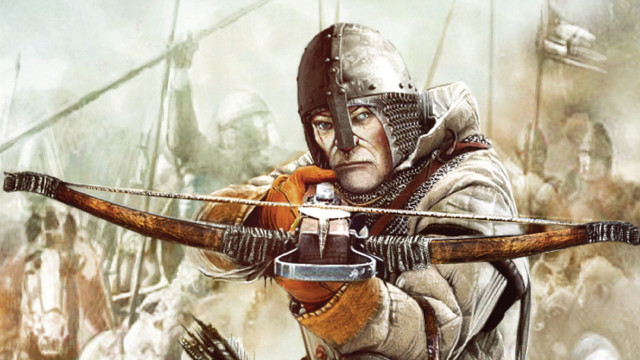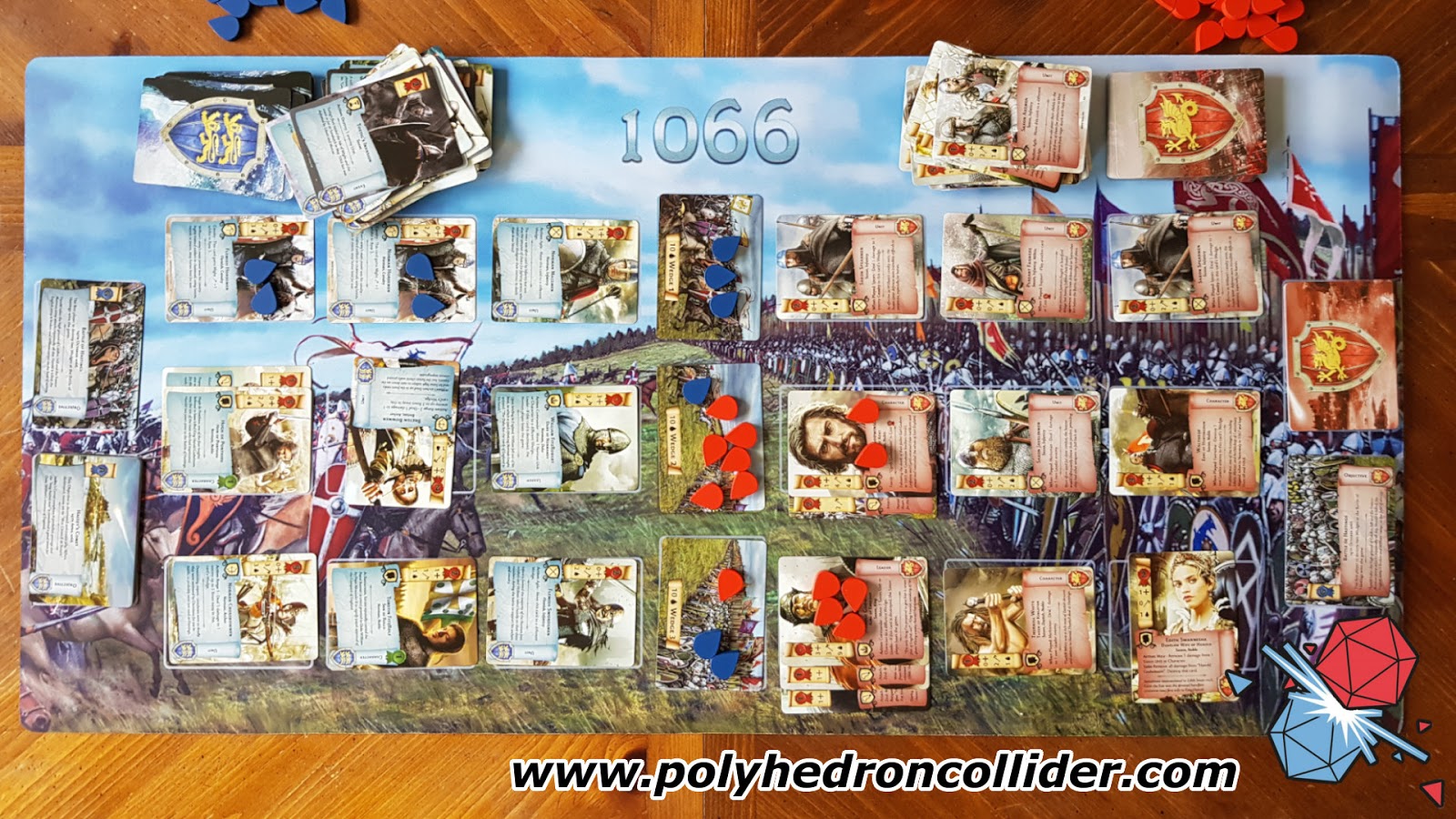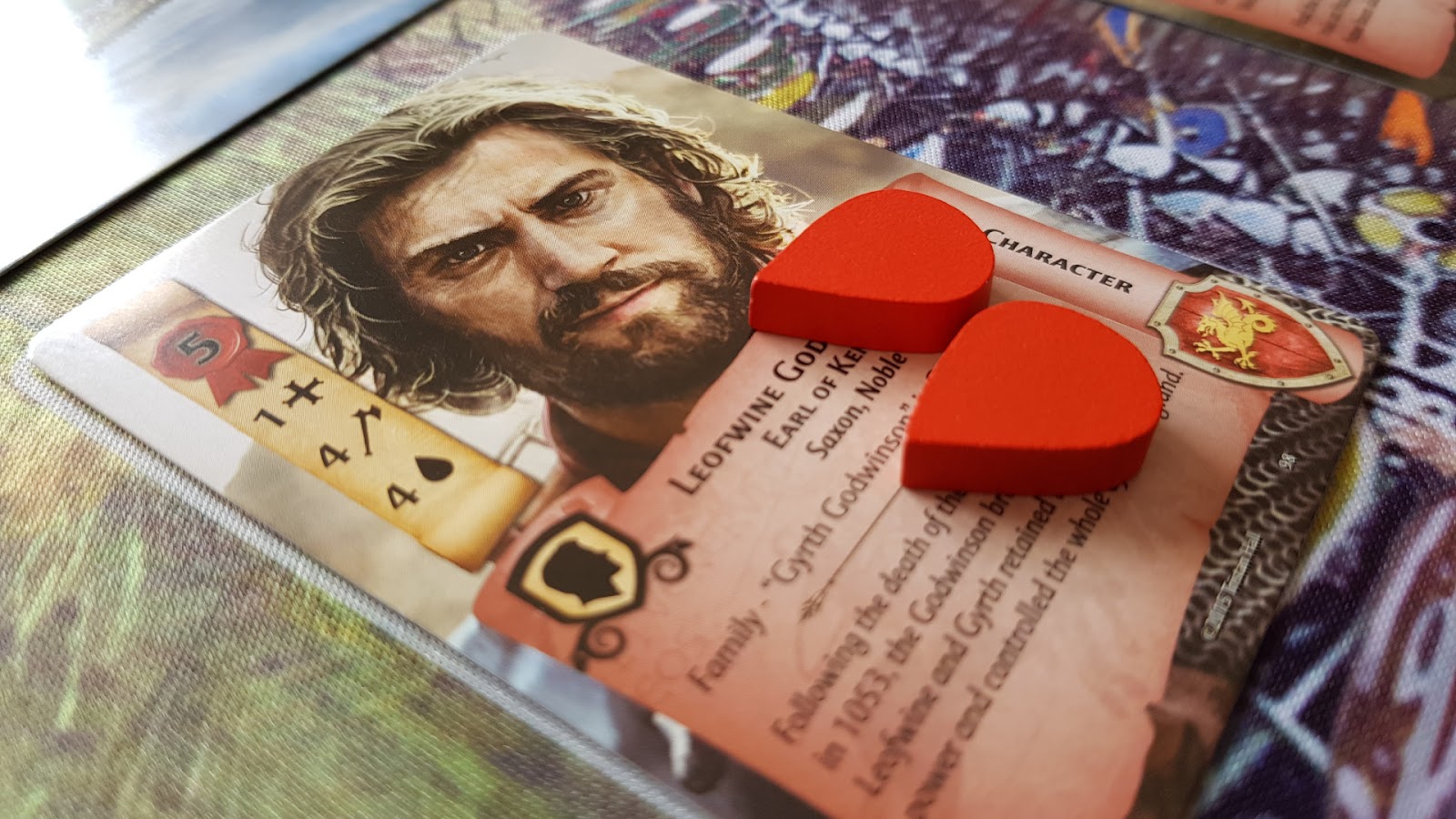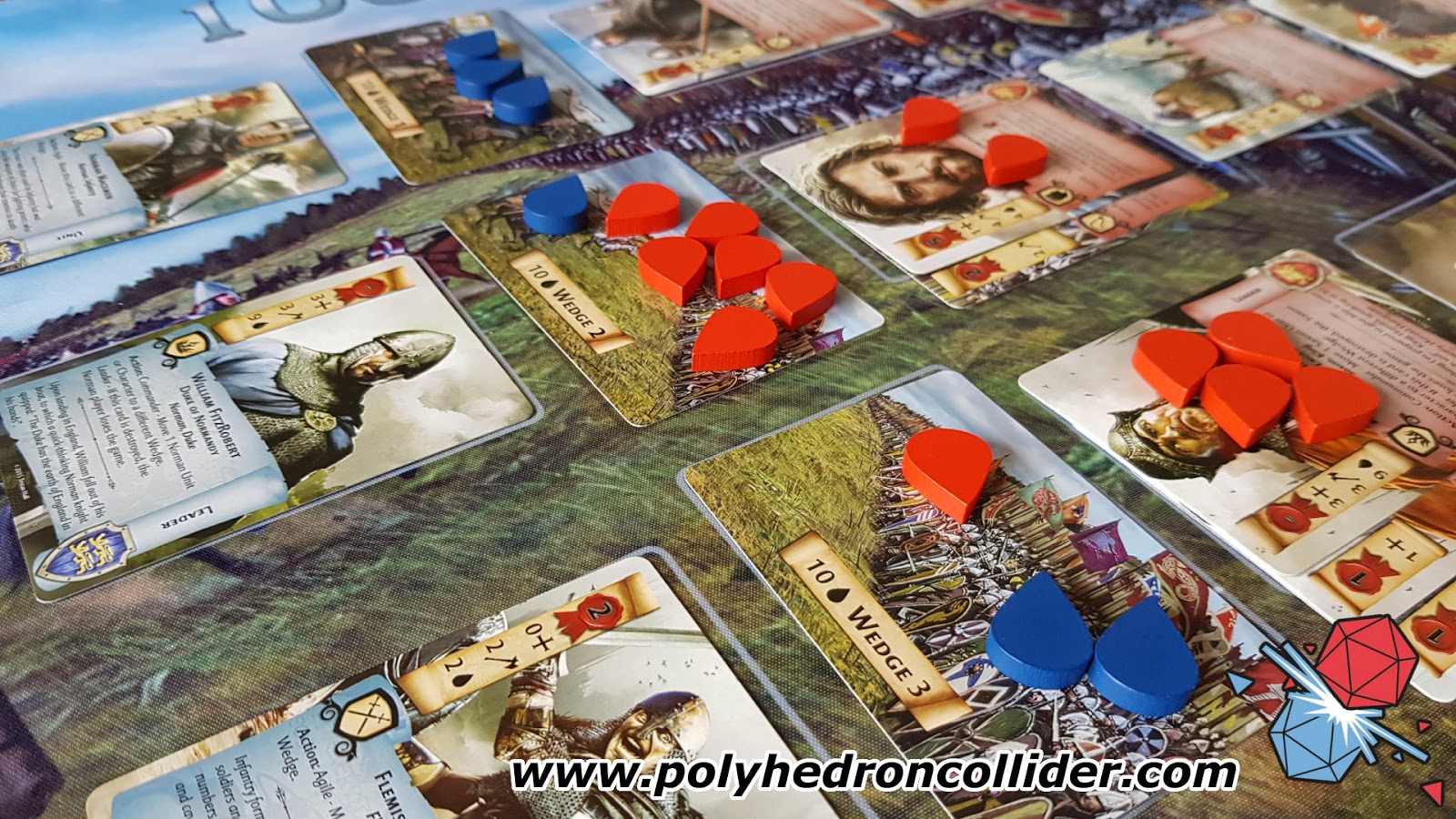1066, Tears to Many Mothers is an all-out offensive two player game covering one of the most important events in English history, the Battle of Hastings, you know, the one where King Harold took an arrow in the eye. This game, from Tristain Hall is carefully balanced, nuanced and heavily detailed pulling from pretty much every page of the Doomsday Book.
It’s taken me a little while to write this review, primarily because of how detailed this game is, my first impression left me wondering if I had missed some key strategy to the game but it also left me with a feeling that I needed to explore the game further and upon doing so I found a deep and rich strategy game.
Mechanically the game is pretty simple and I won’t go into the rules of the game too much here, suffice to say each card has a cost, this cost can be paid be discarding cards from your hand or by resting previously played cards that generate a resource. The key values on the cards are Might and Zeal, which could be trivialised as different types of attack but they are a bit more than this. Each player has a deck of objective cards that must be met in order to progress your army eventually to the famous English battlefield. Both on this journey and at the final arena, Might and Zeal accumulate to represent your entire army’s strength of arms or strength of belief.
There are different types of cards, of course, units, characters, events, tactics and so on. Some go down onto the battle where they have more actions, archers shoot arrows to knock off your opponent’s characters and units, and some provide a resource to enable you to pay for more cards. Events cause things to happen like reducing costs or immediately completing objective steps. And so on.
The placement of these cards is unsurprisingly very important, 1066 is a war game after all, but it is very simple. Three columns, three rows and you have to fill rows from first to last. You can move cards once they are down but if they are moving they aren't contributing to your attacks, so you need to get placements right early on, but not so early on that important cards can be riddled with arrows.
The type of card and its placement is part of this game, ultimately your main focus lies on the Might and Zeal values. You don't need a lot of cards down on the table to win (although it doesn't hurt), you need the right combination of the right ones. Accomplishing this task however is almost a game unto itself.
Each time I play 1066, whether I win or lose I’m left with the niggling sensation that I could have been more efficient, that I could have played better. I’m convinced that in each game there were opportunities that I must have missed, or that my timing of that deployment or that action wasn’t ideal. It’s with these niggles that I feel encouraged to revisit the game, because I have the belief that it is me, not the deck, that is responsible for the margin of my victory (or loss).
A lot of what happens in every game is by and large at the mercy of pre-built Saxon or Norman deck and the cards you are dealt. For some, this maybe too little control and I have found it to be somewhat irksome in more than one game. However, for me, it’s not a case of too many random threads, rather that much of the challenge of this game is finding a way to combine these errant cards into one cohesive whole, in much the same way the A-Team manages to build a hovercraft from an office chair, an inflatable pool and a blender, you need to see and plan the potential of what is in your hand and already on the battlefield.
Bear in mind though that the battlefield is exactly that, a battlefield and anything placed there stands a very good chance of being killed. When it comes to some of the fancier, more powerful characters and units that you deploy, you might, if you’re anything like me, experience an almost visceral reaction to their death. This reaction will probably include a fair amount of swearing, name calling and quite possibly a very punchable smug-faced opponent. The loss of a character in this game is a gut punch, which although being a horrible sensation, is a reaction I wasn’t expecting to get from a card game. I remember, with a burning rage, that feeling from the days when I used to play table top war games - you know, that unit you’ve spent ages gluing together, customising and painting only to have it become the play thing of a Night Goblin Fanatic before its first encounter. I’m not bitter about that Mike, I just remember, that’s all.
I digress, but the point is that 1066 creates this feeling too. Every card that you’ve played hasn’t simply had a cost but has been a cost too. Each card is a cog in your war machine, has a part to play in your plan and its untimely removal...well, quite frankly it will piss you off.
One thing that surprised me with this game is the duality between the forces. The Saxons and Normans (at least in this game) are almost a reflection of one another, not in an oppositional sense as you might expect, it’s more nuanced and symmetrical. This leads to both forces being very similar to play with, but with a different feel and weighting. Each army has its own purpose and this feeling comes through in the cards. It’s most obvious in the objectives that each army must face to get to Hastings, Saxons require a lot of Might early on where as the Normans must rely on Zeal to get them to the English shore.
This duality can be seen again in the sparse synergy between cards, by sparse I mean "little and often" not merge, as there is plenty of "synergy" but infrequently is it the right type. Family members connect to provide cost savings, units from this place receive a Might bonus here. All these interconnected threads makes it feel like it’s more than just a deck of cards and more like a story. When it works that is.
There are so many cards in each deck and so many different links that the process of finding these connections means you’ll have to remember you have part on the table, another in your hand and that yet another part was discarded/killed earlier. This ‘deck synergy’ is one of the game’s greatest attractions for me, teasing me with as yet untapped layers of play. However, it comes at a cost, you’ll have to play the game a number of times to begin to realise the potential of any given card and the inherent accumulated wisdom that comes from these means it can be a pretty uneven game when introducing a new player. Multiple re-visits is what this game really wants and it kind of needs you to do, it wants you to become very familiar with one of the armies to anticipate future obstacles on your route to Hastings. This isn't a problem though, as playing it, exploring your tactics and strategy is in itself
Like ogres, onions, cake, and parfait, 1066, Tears to Many Mothers is a game of layers. The labyrinth of card connections, the underpinning character relationships and austere resources - not to mention the historical significance of each card - all combine to create a game that will have you thinking there is another, deeper strategy, a more efficient way to play. For some, this will be too convoluted, but for others, the journey to the English crown is an itch that will need to be scratched.
This review is based on a full retail copy of the game.


















.png)


0 comments:
Post a Comment